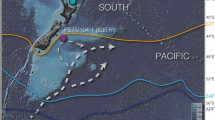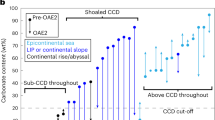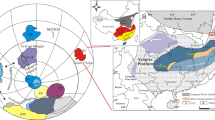Abstract
During the Aptian Oceanic Anoxic Event 1a, about 120 million years ago, black shales were deposited in all the main ocean basins1. The event was also associated with elevated sea surface temperatures2,3 and a calcification crisis in calcareous nannoplankton4. These environmental changes have been attributed to variations in atmospheric CO2 concentrations2,3,5,6, but the evolution of the carbon cycle during this event is poorly constrained. Here we present records of atmospheric CO2 concentrations across Oceanic Anoxic Event 1a derived from bulk and compound-specific δ13C from marine rock outcrops in southern Spain and Tunisia. We find that CO2 concentrations doubled in two steps during the oceanic anoxic event and remained above background values for approximately 1.5–2 million years before declining. The rise of CO2 concentrations occurred over several tens to hundreds of thousand years, and thus was unlikely to have resulted in any prolonged surface ocean acidification, suggesting that CO2 emissions were not the primary cause of the nannoplankton calcification crisis. We find that the period of elevated CO2 concentrations coincides with a shift in the oceanic osmium-isotope inventory7 associated with emplacement of the Ontong Java Plateau flood basalts, and conclude that sustained volcanic outgassing was the primary source of carbon dioxide during Oceanic Anoxic Event 1a.
This is a preview of subscription content, access via your institution
Access options
Subscribe to this journal
Receive 12 print issues and online access
$259.00 per year
only $21.58 per issue
Buy this article
- Purchase on Springer Link
- Instant access to full article PDF
Prices may be subject to local taxes which are calculated during checkout



Similar content being viewed by others
References
Jenkyns, H. C. Geochemistry of oceanic anoxic events. Geochem. Geophys. Geosyst. 11, Q03004 (2010).
Mutterlose, J., Bottini, C., Schouten, S. & Sinninghe Damsté, J. S. High sea-surface temperatures during the early Aptian Oceanic Anoxic Event 1a in the boreal realm. Geology 42, 439–442 (2014).
Ando, A., Kaiho, K., Kawahata, H. & Kakegawa, T. Timing and magnitude of early Aptian extreme warming: unraveling primary δ18O variation in indurated pelagic carbonates at Deep Sea Drilling Project Site 463, central Pacific Ocean. Palaeogeogr. Palaeoclimatol. Palaeoecol. 260, 463–476 (2008).
Erba, E. Nannofossils and superplumes: the early Aptian ‘nannoconid crisis’. Paleoceanography 9, 483–501 (1994).
Erba, E., Bottini, C., Weissert, H. J. & Keller, C. E. Calcareous nannoplankton response to surface-water acidification around Oceanic Anoxic Event 1a. Science 329, 428–432 (2010).
Méhay, S. et al. A volcanic CO2 pulse triggered the Cretaceous Oceanic Anoxic Event 1a and a biocalcification crisis. Geology 37, 819–822 (2009).
Bottini, C., Cohen, A. S., Erba, E., Jenkyns, H. C. & Coe, A. L. Osmium-isotope evidence for volcanism, weathering, and ocean mixing during the early Aptian OAE 1a. Geology 40, 583–586 (2012).
Kump, L. R., Bralower, T. J. & Ridgwell, A. Ocean acidification in deep time. Oceanography 22, 94–107 (2009).
Gibbs, S. J., Robinson, S. A., Bown, P. R., Jones, T. D. & Henderiks, J. Comment on ‘Calcareous nannoplankton response to surface-water acidification around Oceanic Anoxic Event 1a’. Science 332, 175 (2011).
Heimhofer, U., Hochuli, P. A., Herrle, J. O., Andersen, N. & Weissert, H. Absence of major vegetation and palaeoatmospheric p CO 2 changes associated with Oceanic Anoxic Event 1a (Early Aptian, SE France). Earth Planet. Sci. Lett. 223, 303–318 (2004).
van Breugel, Y. et al. Synchronous negative carbon isotope shifts in marine and terrestrial biomarkers at the onset of the early Aptian oceanic anoxic event 1a: evidence for the release of 13C-depleted carbon into the atmosphere. Paleoceanography 22, PA1210 (2007).
Beerling, D. J., Lomas, M. R. & Gröcke, D. R. On the nature of methane gas-hydrate dissociation during the Toarcian and Aptian Oceanic anoxic events. Am. J. Sci. 302, 28–49 (2002).
Hönisch, B. et al. The geological record of ocean acidification. Science 335, 1058–1063 (2012).
Li, Y.-X. et al. Toward an orbital chronology for the early Aptian Oceanic Anoxic Event (OAE1a, ∼120 Ma). Earth Planet. Sci. Lett. 271, 88–100 (2008).
Malinverno, A., Erba, E. & Herbert, T. D. Orbital tuning as an inverse problem: chronology of the early Aptian Oceanic Anoxic Event 1a (Selli Level) in the Cismon APTICORE. Paleoceanography 25, PA2203 (2010).
Kuhnt, W., Holbourn, A. & Moullade, M. Transient global cooling at the onset of early Aptian Oceanic Anoxic Event (OAE) 1a. Geology 39, 323–326 (2011).
Lorenzen, J. et al. A new sediment core from the Bedoulian (Lower Aptian) stratotype at Roquefort-La Bédoule, SE France. Cretac. Res. 39, 6–16 (2013).
de Gea, G. A., Castro, J. M., Aguado, R., Ruiz-Ortiz, P. A. & Company, M. Lower Aptian carbon isotope stratigraphy from a distal carbonate shelf setting: the Cau section, Prebetic zone, SE Spain. Palaeogeogr. Palaeoclimatol. Palaeoecol. 200, 207–219 (2003).
Aguado, R., Castro, J. M., Company, M. & Alfonso De Gea, G. Aptian bio-events—an integrated biostratigraphic analysis of the Almadich Formation, Inner Prebetic Domain, SE Spain. Cretac. Res. 20, 663–683 (1999).
Quijano, M. L. et al. Organic geochemistry, stable isotopes, and facies analysis of the Early Aptian OAE—New records from Spain (Western Tethys). Palaeogeogr. Palaeoclimatol. Palaeoecol. 365–366, 276–293 (2012).
Kump, L. R. & Arthur, M. A. Interpreting carbon-isotope excursions: carbonates and organic matter. Chem. Geol. 161, 181–198 (1999).
Jarvis, I., Lignum, J. S., Gröcke, D. R., Jenkyns, H. C. & Pearce, M. A. Black shale deposition, atmospheric CO2 drawdown, and cooling during the Cenomanian–Turonian Oceanic Anoxic Event. Paleoceanography 26, PA3201 (2011).
Menegatti, A. P. et al. High-resolution δ13C stratigraphy through the Early Aptian ‘Livello Selli’ of the Alpine Tethys. Paleoceanography 13, 530–545 (1998).
Sinninghe Damsté, J. S., Kuypers, M. M. M., Pancost, R. D. & Schouten, S. The carbon isotopic response of algae, (cyano)bacteria, archaea and higher plants to the late Cenomanian perturbation of the global carbon cycle: insights from biomarkers in black shales from the Cape Verde Basin (DSDP Site 367). Org. Geochem. 39, 1703–1718 (2008).
Royer, D. L., Pagani, M. & Beerling, D. J. Geobiological constraints on Earth system sensitivity to CO2 during the Cretaceous and Cenozoic. Geobiology 10, 298–310 (2012).
Heldt, M., Bachmann, M. & Lehmann, J. Microfacies, biostratigraphy, and geochemistry of the hemipelagic Barremian–Aptian in north-central Tunisia: influence of the OAE 1a on the southern Tethys margin. Palaeogeogr. Palaeoclimatol. Palaeoecol. 261, 246–260 (2008).
Tejada, M. L. G. et al. Ontong Java Plateau eruption as a trigger for the early Aptian oceanic anoxic event. Geology 37, 855–858 (2009).
Ridgwell, A. & Schmidt, D. N. Past constraints on the vulnerability of marine calcifiers to massive carbon dioxide release. Nature Geosci. 3, 196–200 (2010).
Uchikawa, J. & Zeebe, R. E. Examining possible effects of seawater pH decline on foraminiferal stable isotopes during the Paleocene–Eocene Thermal Maximum. Paleoceanography 25, PA2216 (2010).
Popp, B. N., Takigiku, R., Hayes, J. M., Louda, J. W. & Baker, E. W. The post-Paleozoic chronology and mechanism of 13C depletion in primary marine organic matter. Am. J. Sci. 289, 436–454 (1989).
Popp, B. N. et al. Effect of Phytoplankton cell geometry on carbon isotopic fractionation. Geochim. Cosmochim. Acta 62, 69–77 (1998).
Laws, E. A., Popp, B. N., Cassar, N. & Tanimoto, J. 13C discrimination patterns in oceanic phytoplankton: likely influence of CO2 concentrating mechanisms, and implications for palaeoreconstructions. Funct. Plant Biol. 29, 323–333 (2002).
Bidigare, R. R. et al. Consistent fractionation of 13C in nature and in the laboratory: growth-rate effects in some haptophyte algae. Glob. Biogeochem. Cycles 11, 279–292 (1997).
Weiss, R. F. Carbon dioxide in water and seawater: the solubility of a non-ideal gas. Mar. Chem. 2, 203–215 (1974).
Pagani, M., Zachos, J. C., Freeman, K. H., Tipple, B. & Bohaty, S. Marked decline in atmospheric carbon dioxide concentrations during the Paleogene. Science 309, 600–603 (2005).
Schoon, P. L., Sluijs, A., Sinninghe Damsté, J. S. & Schouten, S. Stable carbon isotope patterns of marine biomarker lipids in the Arctic Ocean during Eocene Thermal Maximum 2. Paleoceanography 26, PA3215 (2011).
Seki, O. et al. Alkenone and boron-based Pliocene p CO 2 records. Earth Planet. Sci. Lett. 292, 201–211 (2010).
Badger, M. P. S. et al. CO2 drawdown following the middle Miocene expansion of the Antarctic Ice Sheet. Paleoceanography 28, 42–53 (2013).
Raymo, M. E., Grant, B., Horowitz, M. & Rau, G. H. Mid-Pliocene warmth: stronger greenhouse and stronger conveyor. Mar. Micropaleontol. 27, 313–326 (1996).
Freeman, K. H. & Hayes, J. M. Fractionation of carbon isotopes by phytoplankton and estimates of ancient CO2 levels. Glob. Biogeochem. Cycles 6, 185–198 (1992).
Bice, K. L. et al. A multiple proxy and model study of Cretaceous upper ocean temperatures and atmospheric CO2 concentrations. Paleoceanography 21, PA2002 (2006).
Schouten, S. et al. Biosynthetic effects on the stable carbon isotopic compositions of algal lipids: implications for deciphering the carbon isotopic biomarker record. Geochim. Cosmochim. Acta 62, 1397–1406 (1998).
van Bentum, E. C., Reichart, G. J., Forster, A. & Sinninghe Damsté, J. S. Latitudinal differences in the amplitude of the OAE-2 carbon isotopic excursion: p CO 2 and paleo productivity. Biogeosciences 9, 717–731 (2012).
Schouten, S., van Kaam-Peters, H. M. E., Rijpstra, W. I. C., Schoell, M. & Sinninghe Damsté, J. S. Effects of an oceanic anoxic event on the stable carbon isotopic composition of early Toarcian carbon. Am. J. Sci. 300, 1–22 (2000).
Romanek, C. S., Grossman, E. L. & Morse, J. W. Carbon isotopic fractionation in synthetic aragonite and calcite: effects of temperature and precipitation rate. Geochim. Cosmochim. Acta 56, 419–430 (1992).
Mook, W. G., Bommerson, J. C. & Staverman, W. H. Carbon isotope fractionation between dissolved bicarbonate and gaseous carbon dioxide. Earth Planet. Sci. Lett. 22, 169–176 (1974).
Halverson, G. P., Hoffman, P. F., Schrag, D. P., Maloof, A. C. & Rice, A. H. N. Toward a Neoproterozoic composite carbon-isotope record. Geol. Soc. Am. Bull. 117, 1181–1207 (2005).
Jenkyns, H. C. in Proceedings of the Ocean Drilling Program, Scientific Results Vol. 143 (eds Winterer, E. L., Sager, W. W., Firth, J. V. & Sinton, J. M.) 99–104 (Ocean Drilling Program, 1995).
Stoll, H. M. Limited range of interspecific vital effects in coccolith stable isotopic records during the Paleocene–Eocene thermal maximum. Paleoceanography 20, PA1007 (2005).
Dumitrescu, M. & Brassell, S. C. Compositional and isotopic characteristics of organic matter for the early Aptian Oceanic Anoxic Event at Shatsky Rise, ODP Leg 198. Palaeogeogr. Palaeoclimatol. Palaeoecol. 235, 168–191 (2006).
Grantham, P. J. & Wakefield, L. L. Variations in the sterane carbon number distributions of marine source rock derived crude oils through geological time. Org. Geochem. 12, 61–73 (1988).
Schwark, L. & Empt, P. Sterane biomarkers as indicators of palaeozoic algal evolution and extinction events. Palaeogeogr. Palaeoclimatol. Palaeoecol. 240, 225–236 (2006).
Volkman, J. Sterols in microorganisms. Appl. Microbiol. Biotechnol. 60, 495–506 (2003).
Brassell, S. C. & Dumitrescu, M. Recognition of alkenones in a lower Aptian porcellanite from the west-central Pacific. Org. Geochem. 35, 181–188 (2004).
Dumitrescu, M. & Brassell, S. C. Biogeochemical assessment of sources of organic matter and paleoproductivity during the early Aptian Oceanic Anoxic Event at Shatsky Rise, ODP Leg 198. Org. Geochem. 36, 1002–1022 (2005).
Bottini, C. et al. Climate variability and ocean fertility during the Aptian Stage. Clim. Past 11, 383–402 (2015).
Andersen, N., Müller, P. J., Kirst, G. & Schneider, R. R. in Use of Proxies in Paleoceanography (eds Fischer, G. & Wefer, G.) Ch. 19, 469–488 (Springer, 1999).
Schulte, S., Benthien, A., Andersen, N., Müller, P. J. & Schneider, R. in The South Atlantic in the Late Quaternary: Reconstruction of Material Budget and Current Systems (eds Wefer, G., Mulitza, S. & Ratmeyer, V.) 195–211 (Springer, 2003).
Pagani, M. The alkenone-CO2 Proxy and ancient atmospheric carbon dioxide. Phil. Trans. R. Soc. Lond. A 360, 609–632 (2002).
Kuypers, M. M. M., van Breugel, Y., Schouten, S., Erba, E. & Sinninghe Damsté, J. S. N2-fixing cyanobacteria supplied nutrient N for Cretaceous oceanic anoxic events. Geology 32, 853–856 (2004).
Pancost, R. D. et al. Reconstructing Late Ordovician carbon cycle variations. Geochim. Cosmochim. Acta 105, 433–454 (2013).
Schouten, S., Hopmans, E. C., Schefuss, E. & Sinninghe Damsté, J. S. Distributional variations in marine crenarchaeotal membrane lipids: a new tool for reconstructing ancient sea water temperatures? Earth Planet. Sci. Lett. 204, 265–274 (2002).
Schouten, S. et al. Extremely high sea-surface temperatures at low latitudes during the middle Cretaceous as revealed by archaeal membrane lipids. Geology 31, 1069–1072 (2003).
Schouten, S., Hopmans, E. C. & Sinninghe Damsté, J. S. The effect of maturity and depositional redox conditions on archaeal tetraether lipid palaeothermometry. Org. Geochem. 35, 567–571 (2004).
Schouten, S., Hopmans, E. C. & Sinninghe Damsté, J. S. The organic geochemistry of glycerol dialkyl glycerol tetraether lipids: a review. Org. Geochem. 54, 19–61 (2013).
Kim, J.-H. et al. New indices and calibrations derived from the distribution of crenarchaeal isoprenoid tetraether lipids: implications for past sea surface temperature reconstructions. Geochim. Cosmochim. Acta 74, 4639–4654 (2010).
Littler, K., Robinson, S. A., Bown, P. R., Nederbragt, A. J. & Pancost, R. D. High sea-surface temperatures during the Early Cretaceous Epoch. Nature Geosci. 4, 169–172 (2011).
Jenkyns, H. C., Forster, A., Schouten, S. & Sinninghe Damsté, J. S. High temperatures in the Late Cretaceous Arctic Ocean. Nature 432, 888–892 (2004).
Jenkyns, H. C., Schouten-Huibers, L., Schouten, S. & Sinninghe Damsté, J. S. Warm Middle Jurassic–Early Cretaceous high-latitude sea-surface temperatures from the Southern Ocean. Clim. Past 8, 215–226 (2012).
Tarduno, J. A. et al. Evidence for extreme climatic warmth from Late Cretaceous Arctic vertebrates. Science 282, 2241–2243 (1998).
Dumitrescu, M., Brassell, S. C., Schouten, S., Hopmans, E. C. & Sinninghe Damsté, J. S. Instability in tropical Pacific sea-surface temperatures during the early Aptian. Geology 34, 833–836 (2006).
Hopmans, E. C. et al. A novel proxy for terrestrial organic matter in sediments based on branched and isoprenoid tetraether lipids. Earth Planet. Sci. Lett. 224, 107–116 (2004).
Pearson, P. N. et al. Stable warm tropical climate through the Eocene Epoch. Geology 35, 211–214 (2007).
Hu, X., Zhao, K., Yilmaz, I. O. & Li, Y. Stratigraphic transition and palaeoenvironmental changes from the Aptian Oceanic Anoxic Event 1a (OAE1a) to the Oceanic Red Bed 1 (ORB1) in the Yenicesihlar section, central Turkey. Cretac. Res. 38, 40–51 (2012).
Huck, S., Heimhofer, U., Rameil, N., Bodin, S. & Immenhauser, A. Strontium and carbon-isotope chronostratigraphy of Barremian–Aptian shoal-water carbonates: northern Tethyan platform drowning predates OAE 1a. Earth Planet. Sci. Lett. 304, 547–558 (2011).
Acknowledgements
B.D.A.N. received funding through a Rubicon fellowship, awarded by the Netherlands Organisation for Scientific Research (NWO). Additional funding came from the advanced ERC grant ‘The greenhouse earth system’ (T-GRES). J.M.C. and M.L.Q. were funded by University of Jaén fellowships. D.N.S. was funded by a Royal Society URF. R.D.P. and D.N.S. acknowledge the Royal Society Wolfson Research Merit Award. We wish to thank the University of Jaén (CICT) for the use of analytical facilities and NERC for partial funding of the mass spectrometry facilities at the University of Bristol (contract no. R8/H10/63; www.lsmsf.co.uk). M. Heldt is thanked for providing the samples from Djebel Serdj. This work is a contribution of the research projects CGL2009-10329 and CGL2014-55274-P (Spanish Ministry of Science and Technology), ‘Episodios de Cambio Climático Global’ (Instituto de Estudios Giennenses) and RNM-200 (Junta de Andalucía).
Author information
Authors and Affiliations
Contributions
B.D.A.N., D.N.S. and R.D.P. designed the study. J.M.C. and G.A.D.G. generated the stratigraphy, gathered the samples in the field and prepared the samples for bulk stable isotope analyses. M.L.Q. and J.M.C. conducted the biomarker extraction and characterization of samples from Cau. B.D.A.N. performed the biomarker extraction of samples from Djebel Serdj, measured all compound-specific isotope data for Cau and Djebel Serdj, and wrote the manuscript with contributions from all authors.
Corresponding author
Ethics declarations
Competing interests
The authors declare no competing financial interests.
Supplementary information
Supplementary Information
Supplementary Information (PDF 1500 kb)
Supplementary Information
Supplementary Information (XLSX 75 kb)
Rights and permissions
About this article
Cite this article
Naafs, B., Castro, J., De Gea, G. et al. Gradual and sustained carbon dioxide release during Aptian Oceanic Anoxic Event 1a. Nature Geosci 9, 135–139 (2016). https://doi.org/10.1038/ngeo2627
Received:
Accepted:
Published:
Issue Date:
DOI: https://doi.org/10.1038/ngeo2627
This article is cited by
-
Abrupt episode of mid-Cretaceous ocean acidification triggered by massive volcanism
Nature Geoscience (2023)
-
Molecular characterization of organic matter transformation mediated by microorganisms under anoxic/hypoxic conditions
Science China Earth Sciences (2023)
-
Mid-Cretaceous marine Os isotope evidence for heterogeneous cause of oceanic anoxic events
Nature Communications (2022)
-
Early and late phases of the Permian–Triassic mass extinction marked by different atmospheric CO2 regimes
Nature Geoscience (2022)
-
Response of a continental fault basin to the global OAE1a during the Aptian: Hongmiaozi Basin, Northeast China
Scientific Reports (2021)



